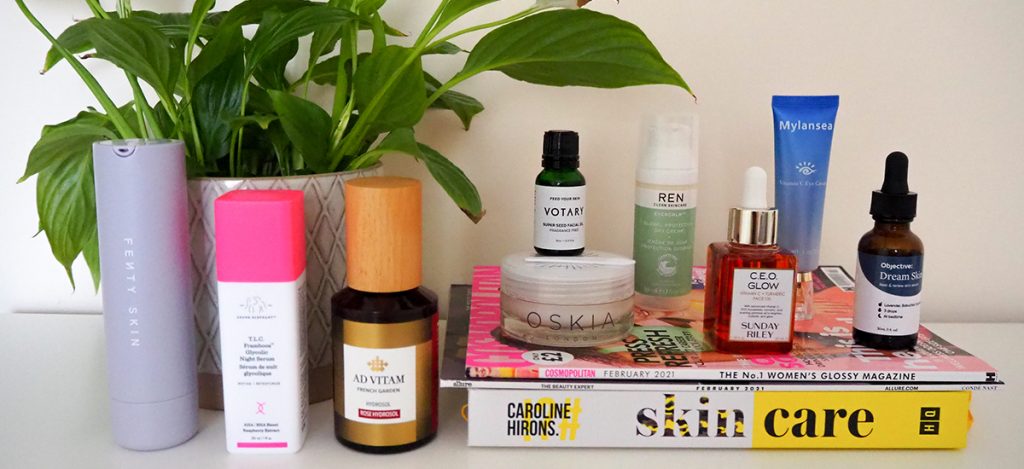Step by step morning and night skincare routine for all the skin types
Step 1: Hydrating Cleanser (Morning & night)

Think of your cleansing routine as the first step to adding nourishing ingredients while preparing your skin to absorb moisture. Your type of cleanser and frequency of exfoliation should depend on your sensitivity to products and your skin's current moisture levels.
Should I Double Cleanse My Skin?
That's totally up to you! Double cleansing can ensure that impurities are removed from the skin, leaving room for additional products to work their magic. You can double cleanse by using an oil cleanser followed by a cream cleanser to refresh your skin and leave a dewy finish.
How Often Should I Exfoliate My Skin?
Use an exfoliator for dry skin once a week to keep skin balanced without stripping away moisture. This will keep your complexion bright while allowing products such as serums to fully penetrate the skin barrier.
What to Look for in a Cleanser?
The best face wash for dry skin will usually have a cream or oil-based texture that helps skin stay soft and hydrated while removing dirt, oil and other impurities. For exfoliating face washes for dry skin, look for alpha-hydroxy acids, known as AHAS, to gently smooth skin.
Step 2: Toner (Morning and Night)
Follow your face wash with a hydrating toner. Toners are one of the most important products in your routine and can be applied with a cotton pad or with your hands in an upward motion.
Toner preps the skin for all the good ingredients in the rest of your skin care routine; consider it a finishing touch to your face wash. The best toner for dry skin will pump up hydration but also restore skin, balance PH and even exfoliate.
What to Look for in a Toner for Dry Skin
Choose a hydrating toner that will help seal in moisture all day and night. Make sure to pick one that's alcohol-free. Ingredients such as glycerin or hyaluronic acid, which add moisture and help lock in hydration, are best.
Step 3: Hydrating Serum (Morning and Night)
Serums are one of the most important parts of your skin care routine and should always follow your toner. When considering the best serum for dry skin, you'll want to choose a hydrating serum that provides moisture and shields against environmental aggressors like pollution.
What to Look for in a Serum
Again, hyaluronic acid is great for your skin because it helps lock in that moisture. But you can also look for other ingredients such as:
Squalane : This is a naturally occurring lipid found
in the skin that helps retain hydration.
Ceramides: These are fats that help skin form a barrier to retain moisture.
Plant oils and extracts: Coconut, shea and jojoba also help skin form a barrier to lock in moisture.
Vitamin C: An antioxidant, this helps protect skin from environmental aggressors, promotes collagen production and can thicken the dermis layer of your skin.
Step 4: Moisturizer (Morning and Night)
Unsurprisingly, moisturizer is one of the best skin care products for morning and night. Choose a lighter moisturizer for daytime and a heavier cream for nighttime.
What Is the Best Moisturizer for Dry Skin?
The ideal moisturizer for dry skin will contain rich, fortifying ingredients that deeply penetrate the skin barrier. This will help skin feel softer, smoother and more plump.
What to Look for in a Moisturizer
In addition to hyaluronic acid, ceramides and glycerin, a good face moisturizer for dry skin will also contain B vitamins like niacinamide. These will help balance your skin's texture-whether you have acne or wrinkles-and can help fade spots, reduce redness and restore evenness to skin.
Step 5: Facial Oil (Morning and Night)
Applying a facial oil after your serum and moisturizer can help add hydration. You can use one day or night (or both). Choose a light oil for daytime and a heavier, richer option for nighttime.
What to Look for in a Face Oil
Opt for oils with antioxidant ingredients like vitamin E or vitamin C.
Step 6: Sunscreen (Morning)
One of the most important steps of any skin care routine is sunscreen. Wear it on your face daily, applying it after your moisturizer or face oil. It's particularly important to wear sunscreen when you have dry skin because harsh UV rays can cause further damage, making your skin drier, stressed and unbalanced. Be sure to reapply it often when you're outdoors in the sun.
What to Look for in a Sunscreen
Choose a lightweight sunscreen that won't clog pores or cause breakouts. (Unfortunately, that can still happen even if your skin is dry.) Go for a chemical or mineral sunscreen of at least SPF 50.
Step 7: Eye Cream (Morning and Night)
If you have dry skin, it's also essential not to forget your eye cream. Make this the last step of your routine, sweeping a tiny bit under the eyes and below the brows. The skin around the eye some of the most delicate on the body, so it needs a little extra care.
what to look for in an eye cream
a great eye cream can prevent dryness as well as sings of aging, fatigue and more. choose a lightweight eye cream that has some of the same nourishing ingredients as the rest of your skin routine. hyaluronic acid, vitamin c, shea butter, collagen and vitamin b can all help restore and retain moisture.
Bonus step :
Use a nourishing face mask as a final step in your regimen to lock in all the powerful ingredients.
overnight cells can also help regenerate your natural cells and hydrate skin as you sleep, giving you an extra boost of moisture and rejuvenation.
Tip: Apply your overnight mask after all your other products and wash it off in the morning before applying any other products.




Comments
Post a Comment